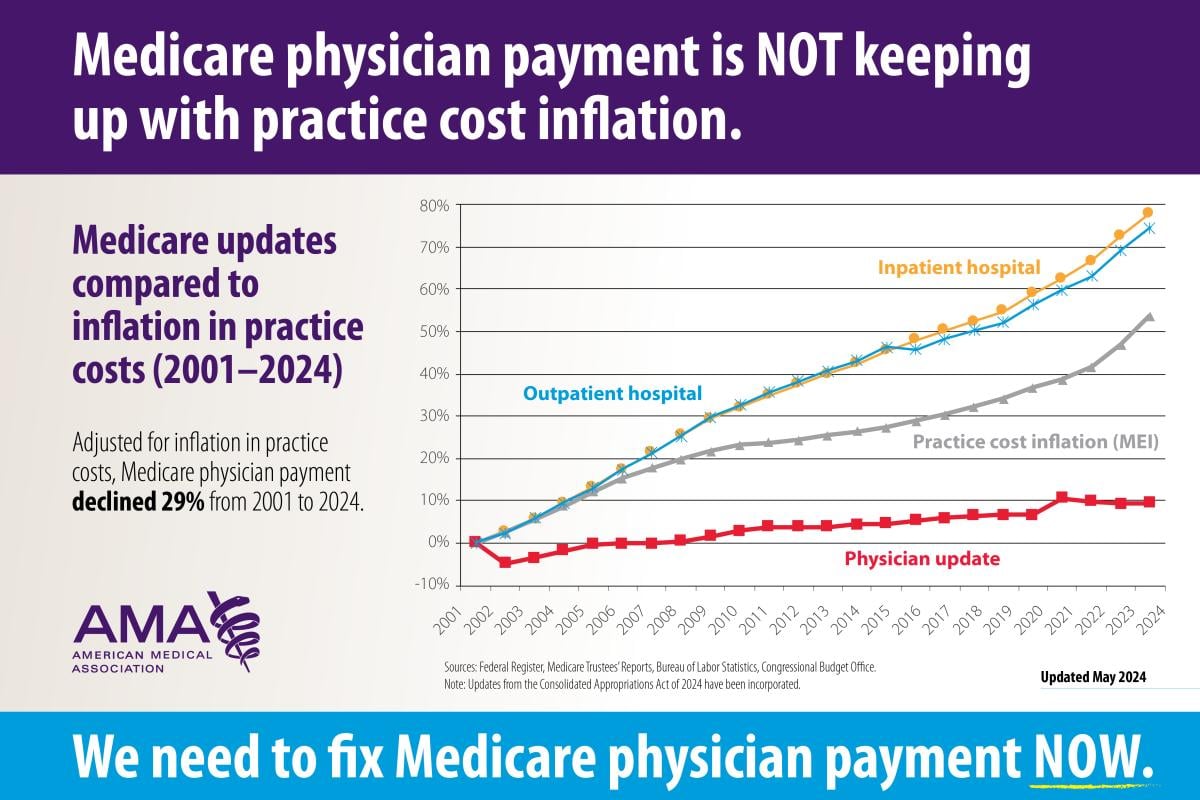What’s the news: Physicians are facing a 2.8% cut in pay under the proposed 2025 Medicare physician payment schedule published today. The proposal from the Centers for Medicare & Medicaid Services (CMS) reinforces the clear need for systemic changes and follows a 1.69% Medicare pay cut in 2024 and 2% drop in 2023.
“With CMS estimating a fifth consecutive year of Medicare payment reductions—this time by 2.8%—it’s evident that Congress must solve this problem,” said AMA President Bruce A. Scott, MD. “In addition to the cut, CMS predicts that the Medicare Economic Index [MEI]—the measure of practice-cost inflation—will increase by 3.6%. Facing this widening gap between what Medicare pays physicians and the cost of delivering quality care to patients, physicians are urging Congress to pass a reform package that would permanently strengthen Medicare."
The AMA is leading the charge to reform the Medicare payment system, which is the AMA’s top advocacy priority.
Learn about how you can take part in the fight to fix Medicare on behalf of your patients and practices at the AMA's Fix Medicare Now website.
Why it’s important: “Physician practices cannot continue to absorb rising costs while their payment rates dwindle,” Dr. Scott said. “The death by a thousand cuts continues. Rural physicians and those treating underserved populations see this CMS warning as another reminder of the painful challenges they face in keeping their practices open and providing care. It’s crucial that we ensure both continue.”
Medicare physician payment effectively declined (PDF) 29% from 2001 to 2024, even before accounting for the newly proposed cut.
It’s widely acknowledged by the experts that chronically inadequate Medicare payment rates will eventually take a toll on older adults’ access to high-quality care.
Among them is the Medicare Payment Advisory Commission (MedPAC), which recognized in its report to Congress earlier this year an unsustainable combination within Medicare physician payment: an inadequate baseline and a lack of an inflation-based update.
Meanwhile, Medicare’s trustees have warned that the physician payment system has failed to keep up with the cost of practicing medicine and that failure could hinder older adults’ access to health care.
“Absent a change in the delivery system or level of update by subsequent legislation, the trustees expect access to Medicare-participating physicians to become a significant issue in the long term,” the trustees said in their most recent report.
The report notes that the Medicare program faces “challenges” as physician payments—which are not based on underlying economic conditions—don’t keep up with inflation or the cost of practicing medicine.
The trustees predicted that, because of the gap between rising costs and falling payments, the “quality of health care received by Medicare beneficiaries would, under current law, fall over time compared to that received by those with private health insurance.”
Many members of Congress from both parties have seen the need for systemic change, and they introduced the bipartisan Strengthening Medicare for Patients and Providers Act, H.R. 2474. That legislation would give physicians an annual, permanent inflationary payment update in Medicare tied to the Medicare Economic Index.
The AMA supports the legislation, and the AMA also put forward a proposal to make the Medicare Merit-based Incentive Payment System (MIPS) “more relevant to patients and supports pending legislation to improve the budget-neutrality process to better reflect actual Medicare costs,” Dr. Scott said.
“The consecutive years of Medicare cuts demand a comprehensive legislative solution,” he added. “Previous quick fixes have been insufficient. This situation requires a bold, substantial approach. A Band-Aid goes only so far when the patient is in dire need.”
Learn more: While the AMA is working relentlessly to build understanding on Capitol Hill about the unsustainable path the Medicare payment system is on, preventing further cuts means getting to the root causes of what’s wrong with Medicare physician payment.
That is why the AMA created the Medicare Basics series, which provides an in-depth look at important aspects of the Medicare physician payment system. With these six straightforward explainers, policymakers and physician advocates can learn about key elements of the payment system and why they are in need of reform.
Visit AMA Advocacy in Action to find out what’s at stake in reforming Medicare payment and other advocacy priorities the AMA is actively working on.





